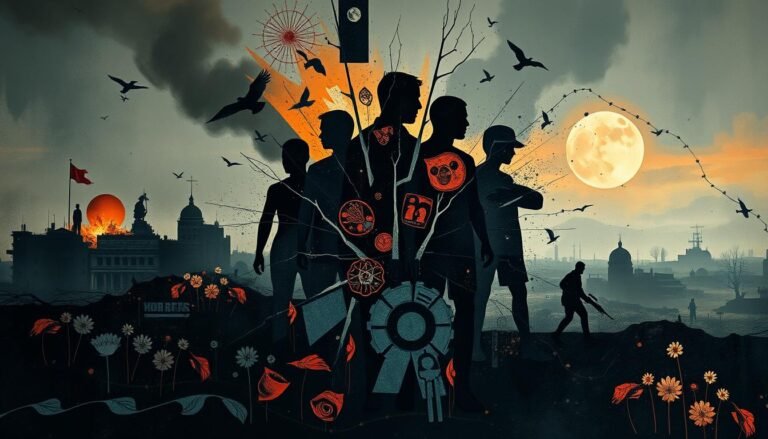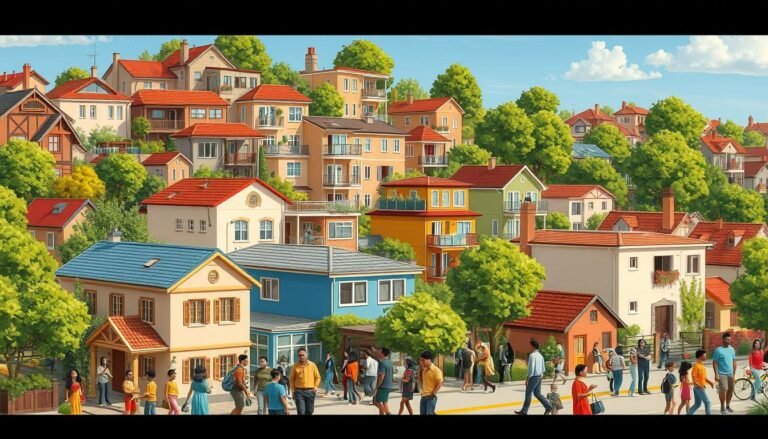Social Theories of Modernization: Pros and Cons
Is the path to progress paved with both promise and peril? We dive into modernization theories and find a complex mix of social change. This mix challenges our view of development studies. It affects everyone, from city dwellers to those in remote areas.
Modernization means adopting new tech and ways of doing things. It changes economies, cultures, and social norms. But, what do we gain and lose in this process?
In development studies, modernization theories help us understand big changes. They show societies moving from traditional to modern, like Western nations. But, some say this view ignores the unique cultures of different places.
Looking at modernization’s pros and cons, we see a delicate balance. Economic growth brings innovation but can also increase inequality. Education opens new doors, but it can also threaten traditional knowledge.
Join us as we explore social change and the good and bad sides of modernization. By understanding these points, we can navigate the complex path of development in our global world.
Key Takeaways
- Modernization theories explore the transition from traditional to modern societies
- Economic growth and technological advancements are key drivers of modernization
- Social and cultural changes accompany modernization processes
- Modernization can lead to improved living standards but may exacerbate inequalities
- Critics argue that modernization theories often overlook local contexts and traditions
- Understanding both pros and cons is crucial for balanced development strategies
Understanding Modernization Theory: A Comprehensive Overview
Modernization theory started in the 1960s to explain how societies change with global shifts. It looks at how societies move from traditional to modern states. This includes economic growth, tech progress, and social improvement.
Defining modernization in social context
Modernization means changing from farming to industrial economies in societies. This brings about changes in social structures, values, and political systems. The theory says that economic growth leads to more democratic systems.
Key proponents and their contributions
Many scholars have shaped modernization theory with their work:
- Seymour Martin Lipset (1959) linked economic growth with democracy
- Walt Whitman Rostow described five stages of growth, from traditional to high consumption
- Talcott Parsons stressed the role of Western values in growth and competition
Historical development of modernization theories
After World War II, many countries in Asia, Africa, and South America sought economic growth. Modernization theory pushed for an industrial model, promoting large-scale production and Western values. Critics argue it oversimplifies complex social changes and overlooks different political paths.
“Modernization theory fails to account for diverse political development paths due to its lack of consideration for institutional and cultural influences.”
Despite its flaws, modernization theory still impacts development studies. It influences discussions on economic growth, social change, and political shifts worldwide.
The Core Principles of Modernization Theory
Modernization theory started in the late 1940s to tackle global development issues. It helps explain how societies move from traditional to modern states. The main drivers are economic growth, tech progress, and social change.
This theory believes all countries can follow a similar path to development. It says adopting Western ways and values helps. This idea became popular after World War II. Many countries in Africa, Asia, and Latin America were poor but had seen capitalism.
Walt Rostow’s five-stage model of economic growth shows this idea:
- Traditional Society
- Preconditions for Takeoff
- Takeoff
- Drive to Maturity
- Age of High Mass Consumption
Rostow thought this process would take about 60 years. His model highlights the importance of Western aid and modern practices in boosting development. It fits with the idea that industrialization and capitalism lead to better production and growth.
However, critics say this view is too simple. They doubt if Western models work everywhere. Still, modernization theory is key in development studies and shapes talks on social change.
Economic Growth and Development: A Double-Edged Sword
Economic growth brings both good and bad to societies changing fast. This complex process shapes the future, affecting many parts of life.
Increased productivity and innovation
Modernization often leads to more productivity and new ideas. As economies grow, new tech comes out, making industries more efficient. This means more output and better living for many people.
Technological advancements and their impact
Technology is key to driving economic growth. It changes industries, creates new jobs, and boosts productivity. For example, digital tech has changed how we talk, do finance, and make things.
Widening socioeconomic inequalities
But, economic growth can also make things worse for some people. Some areas might do well, while others fall behind, causing income and opportunity gaps. This can make it hard for society to stick together and grow in a lasting way.
| Aspect | Positive Impact | Negative Impact |
|---|---|---|
| Economic Growth | Increased GDP | Wealth concentration |
| Technological Advancements | Improved efficiency | Job displacement |
| Socioeconomic Inequalities | New opportunities | Widening wealth gap |
Finding a balance between economic growth and fairness is hard for leaders and societies. They need to make sure everyone gets a fair share of the benefits of change.
Social and Cultural Transformations in Modernizing Societies
Modernization leads to big changes in society and culture. As societies change, old ways are questioned. This opens up new social structures and values. It impacts many areas, like gender roles and healthcare.
Women in modernizing societies have made big strides in education and work. In 1959, studies showed that economic growth linked to more political involvement. This often means more equality for women.
Healthcare has also improved a lot with modernization. New medical tech and better healthcare access have raised life expectancy and cut down on infant deaths. These changes affect family life and population numbers.
But, modernization brings challenges too. It can lead to losing local customs and languages, even as it pushes for more inclusivity and tolerance. This struggle between moving forward and holding on to tradition is a big part of modernization.
| Aspect | Traditional Society | Modernizing Society |
|---|---|---|
| Gender Roles | Rigid, often unequal | More flexible, trending towards equality |
| Healthcare | Limited access, traditional methods | Improved access, modern medical practices |
| Cultural Identity | Strong local traditions | Blend of global and local influences |
Rostow’s stages of economic growth help us understand these big changes. As countries go through these stages, they see deep changes in social structures and cultural norms. This reshapes society in big ways.
The Impact of Globalization on Modernization Processes
Since the 1980s, globalization has changed how we modernize. It connects economies, cultures, and tech across the globe.
Cultural Homogenization vs. Local Identity Preservation
Globalization brings cultures together, but it also threatens to erase local identities. Many countries are fighting to keep their unique cultures as global trends take over. This balance is a big challenge in modernizing.
Global Economic Interdependence
Today, the world is more economically connected than ever. China’s growth has boosted the global economy. However, this connection can also have negative effects. The U.S. trade with China led to 3.7 million job losses from 2001 to 2018, especially in manufacturing.
Technological Diffusion Across Borders
Technology sharing is a big part of globalization. Vietnam shows how this works. From 2000 to 2015, Vietnam increased its research capacity a lot. This shows a strong push for modernization and learning.
| Year | Researchers per Million (Vietnam) | Increase from Previous Period |
|---|---|---|
| 2000 | 1075.215 | – |
| 2005 | 1204.33 | 129.218 |
| 2010 | 1282.492 | 78.05 |
| 2015 | 1410.82 | 128.33 |
This data shows how globalization, modernization, and tech growth are linked. It shows the effort to balance global integration with progress and cultural identity.
Critiques of Modernization Theory: Post-Colonial Perspectives
Post-colonial views question modernization theory’s ideas. They say the theory pushes for Western ways, ignoring the special cultures of developing countries. Experts argue that modernization can make developing countries rely too much on Western countries.
Dependency theory came up as a different view. It shows how developed and developing nations have unfair relationships in modernizing. This idea goes against the idea that all countries move forward in a straight line.
Westernization critiques say modernization theory might ignore local knowledge and traditions. They believe focusing too much on Western ways can erase local customs.
“We do not live in a modernizing world but in a capitalist world.” – Immanuel Wallerstein
Since 1970, more studies on modernization theory have been done. Scholars have made the theory better by adding ideas like multiple modernities and global modernity. These ideas try to show that different societies can develop in their own ways.
| Critique | Argument |
|---|---|
| Eurocentrism | Challenges the idea of an anarchical international system |
| State-centricity | Questions the universality of Western concepts like “development” |
| Cultural bias | Highlights the neglect of non-Western knowledge systems |
Post-colonial views keep changing how we think about modernization. They encourage us to look at global development in a way that respects all cultures.
Social Theories of Modernization: Pros and Cons
Modernization theories have changed how we see society’s progress. They show how societies move from traditional to modern states. This includes economic growth, tech advances, and social changes.
Advantages of modernization theories
These theories give us deep insights into how societies change. They help us understand changes and guide development plans. For example, modern education has led to skilled workers and leaders in many places.
- Increased productivity through technological advancements
- Improved education systems and universal access to learning
- Creation of flexible, adaptive social structures
Disadvantages and limitations
Some say modernization theories have biases and focus too much on U.S. development. They might ignore local cultures and values. This could lead to losing cultural identity and more inequality.
- Risk of cultural homogenization
- Environmental challenges due to rapid industrialization
- Widening gap between rich and poor
Balancing tradition and progress
Finding a balance between old traditions and new progress is key. We must think about local cultures, values, and the environment. This way, we can enjoy modern benefits while keeping our cultural identity.
“Education plays an essential role in modernization by creating knowledge, transferring it to students, and fostering innovation.”
When dealing with modernization, we must see both its good and bad sides. By understanding the pros and cons, we can aim for a fair and sustainable way to develop society.
Case Studies: Successes and Failures of Modernization
Modernization has had mixed results. Some countries have seen big successes, while others have faced big failures. Let’s look at a few examples to see how complex modernization can be.
South Korea is a great example of success. It went from an agrarian society to a high-tech leader in just decades. This change was thanks to big investments in education, infrastructure, and technology. According to a 1991 study, South Korea’s economy grew by 7% every year from 1960 to 1985.
In contrast, Tanzania’s ujamaa policy was a failure. The government tried to make farms collectivist and create socialist villages. But this led to no growth and food shortages. A 1992 study pointed out that such plans often ignore local culture and can cause resistance.
| Country | Modernization Approach | Outcome |
|---|---|---|
| South Korea | Export-oriented industrialization | Rapid economic growth, improved living standards |
| Tanzania | Ujamaa policy (forced collectivization) | Economic stagnation, food shortages |
| China | Gradual market reforms | Sustained economic growth, rising inequality |
China’s modernization is more complex. It has seen huge economic growth but also big inequalities and environmental issues. A 1955 study by Kuznets shows how economic growth can also widen social gaps.
These examples show how important it is to adapt modernization plans to local needs. It’s also key to balance economic growth with social and environmental care.
Conclusion: The Future of Modernization Theory in Development Studies
The future of modernization theory in development studies is full of both challenges and chances. It needs to evolve to tackle global issues and embrace different viewpoints. This change is key to grasping social change in our connected world.
Experts like William Easterly have raised doubts about big economic development plans. They note that middle-class wages have dropped since 1979, causing income to stall. These points urge modernization theory to rethink its methods for economic growth and fairness.
The theory’s future depends on mixing old ideas with new ones. It must tackle issues like environmental sustainability and cultural diversity. By doing this, modernization theory can stay useful in understanding how we develop.
As we progress, development studies will likely combine modernization theory with other views. This mix will lead to better strategies for social change. By using past lessons, we can craft a more inclusive and successful approach to global development.
Source Links
- Modernization – Advantages and Disadvantages – Prep With Harshita
- Weaknesses and strenths of modernization theory
- Strength and Weakness of Modernization and Dependency Theory: [Essay Example], 837 words
- Modernization theory
- Modernisation Theory: Overview & Examples
- Modernization Theory
- Modernization Theory – ReviseSociology
- No title found
- Gentrification Pros and Cons: A Double-Edged Sword | Robert F. Smith
- Do Double-Edged Swords Cut Both Ways? The Role of Technology Innovation and Resource Consumption in Environmental Regulation and Economic Performance
- Economic Growth, Human Development, and Welfare (Chapter 4) – Rethinking Society for the 21st Century
- No title found
- Giovanni E. Reyes: Four Main Theories of Development
- Modernization | Nature, Features, Examples, & Facts
- The Key Advantages and Disadvantages of Globalization
- The impact of globalization and modernization of laws and theories on the modernization of philosophy in Vietnam: mediating role of modern societies
- Do Postcolonial Approaches Explain World Politics Better than Other IR Theories?
- No title found
- Dr. Asha Chaudhary / International Journal for Research in Education
- MODERNIZATION AND ITS DISCONTENTS: A Perspective From the Sociology of Knowledge
- No title found
- The Nine Lives of Modernization Theory | Los Angeles Review of Books
- Modernization Theory and the Metaphor of the Development Ladder – HKS Student Policy Review
- Theories of development: Modernisation vs dependency
- Consumerism: Definition, Economic Impact, Pros & Cons







